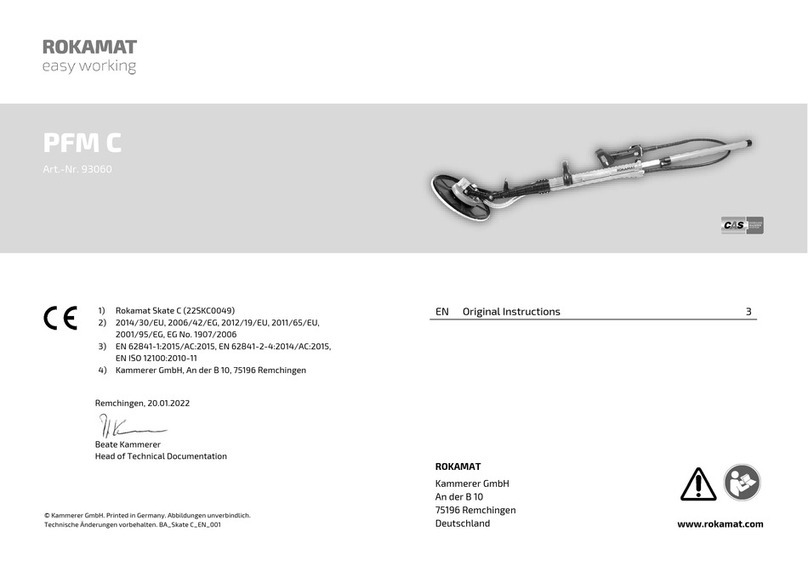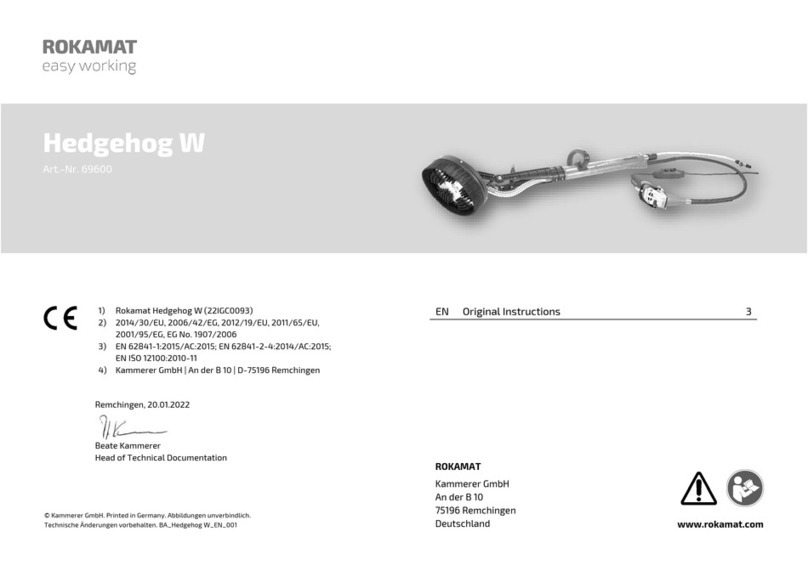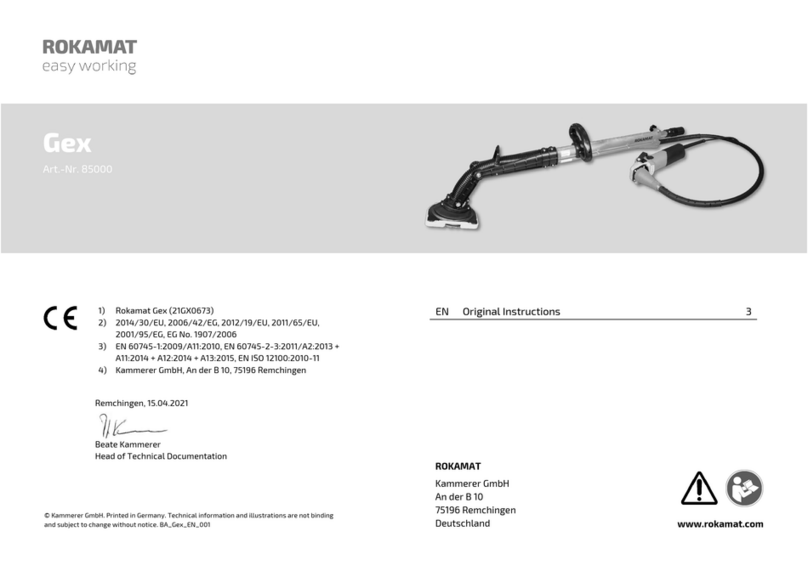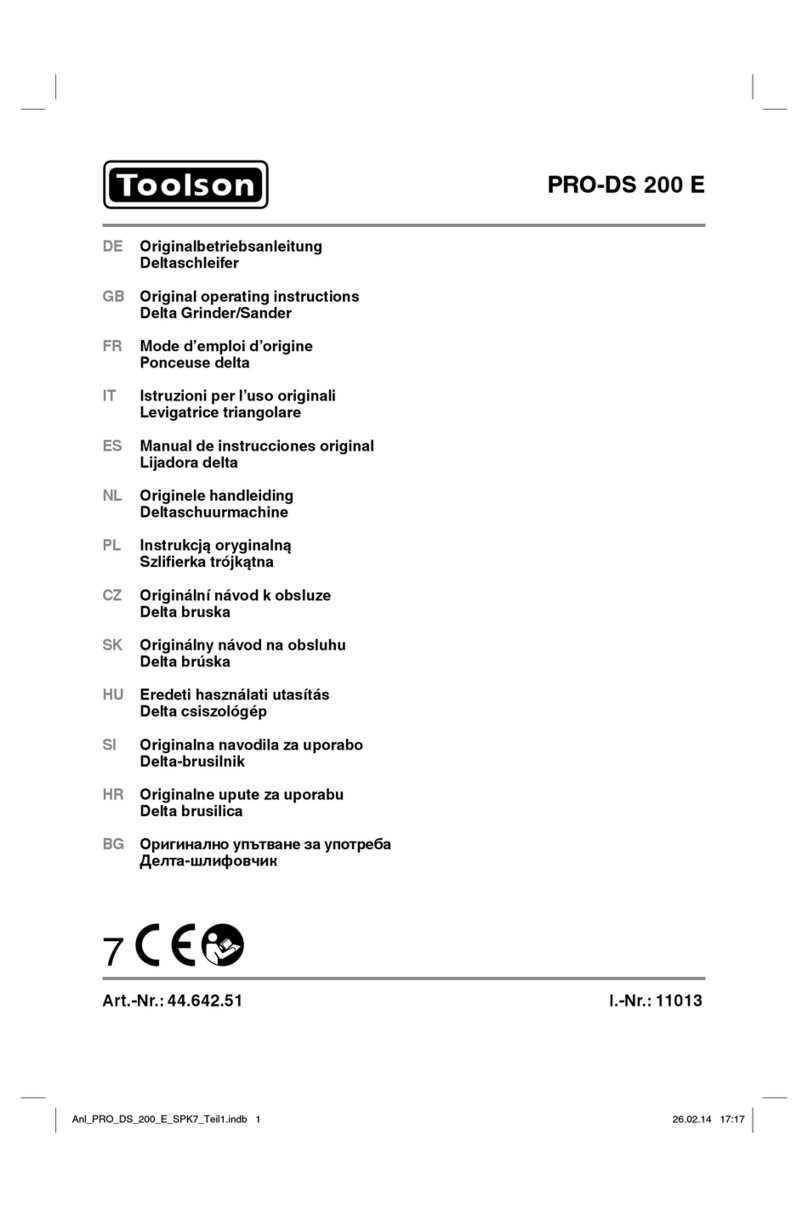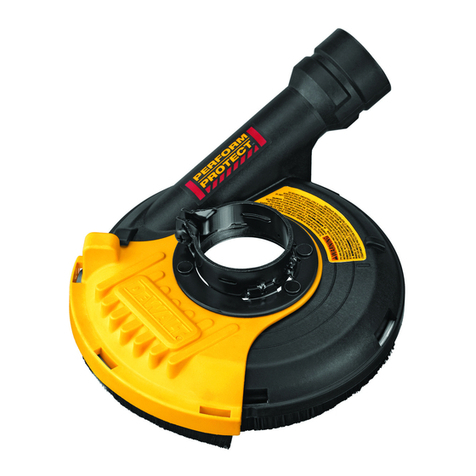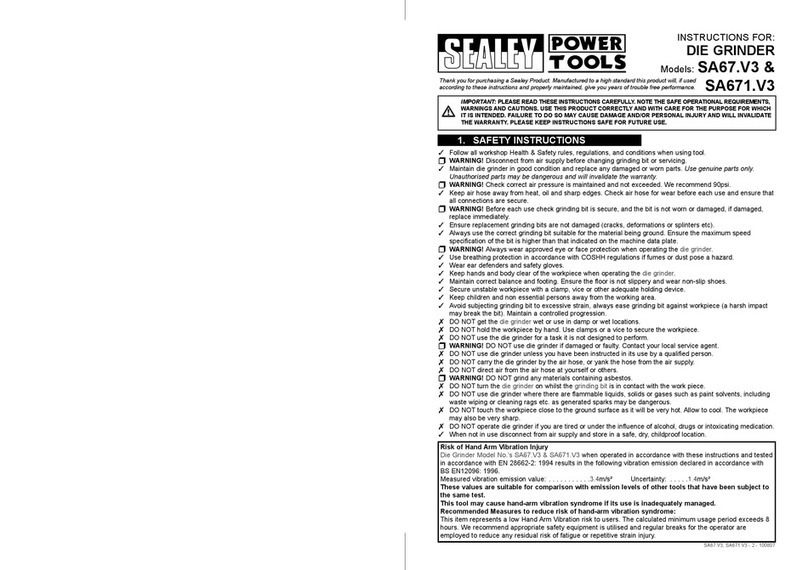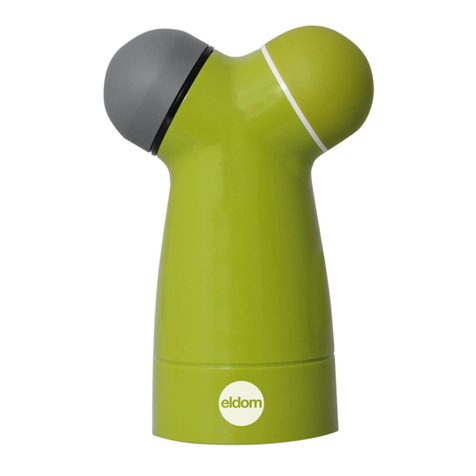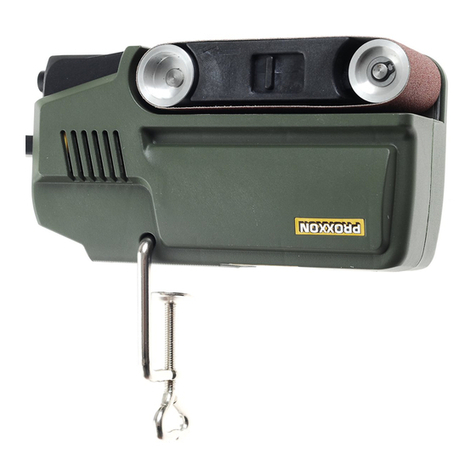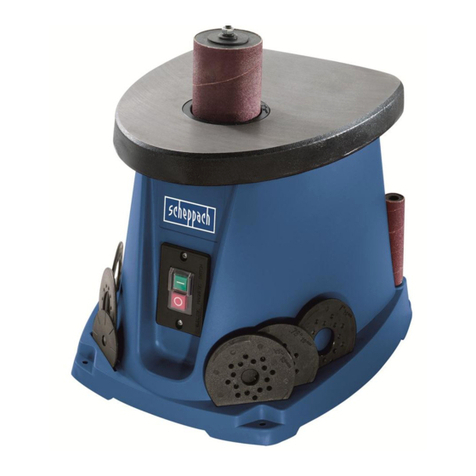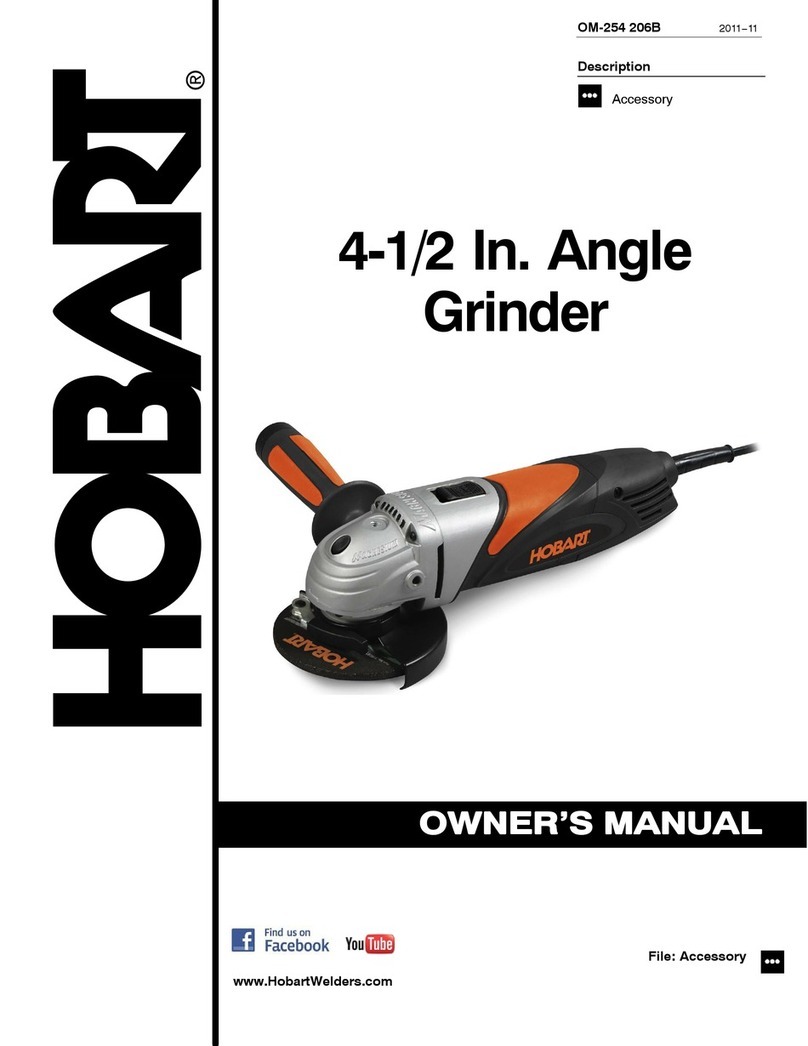ROKAMAT GEX User manual

ROKAMAT GEX Renovation Grinder
ROKAMAT GEX P Parquet Grinder
TRANSLATION OF THE
ORIGINAL INSTRUCTIONS
WARNING Read and follow all safety warnings and instructions to
prevent operating errors and to reduce the risk of injury.
Failure to follow all safety warnings and instructions may result in
electric shock, fire and/or serious injury.
Keep all safety instructions and information for future reference.
Pass on your power tool only together with these documents.
ROKAMAT GEX and GEX P are state of the art and have been constructed
in accordance with the acknowledged safety regulations.
CAUTION GEX and GEX P are EASY-SLIDE grinders; please do
not press the machine during grinding process!
Pull the lever for adjusting the required grinding angle of the machine head to get the optimal posture towards the
respective working face. Take care that both index bolts get engaged when released to fix the grinding angle.
Machining Floors
Take care that the fork is
not angled.The gaiter must
not get squeezed.
.
Machining Walls
Angle the fork in a way that
the tool head is placed at a
right angle to the fork.
Technical Data:
Tool n0: 2600 –9150 min-1
Motor: 230 V ~ 1500 W
Weight tool: 3,1 kg
Max. Grinding tool-ø: 150 mm
Tool holding device-ø: 12 mm
Safety class I
GEX: Reference-No. 85000
Valid from serial No. 15GX0072
GEX P: Reference-No. 84000
Valid from serial No. 16GP0002
Machining Floors
Set the fork in upright
position and hold the
sander inclined to the
floor.
Machining Walls
Take care that the fork is
not upright. The gaiter
must not get squeezed.
.
Machining Ceilings
Set the fork in upright
position and hold the
sander inclined to the
ceiling.
Machining Ceilings
Take care that the fork is
not angled. The gaiter must
not get squeezed.
Angle Adjusting

ROKAMAT GEX is a hand-guided renovation grinder with angle adjustable, highly adaptable grinding head. . It is used for
machining ceilings, walls and floors allowing to work in an upright posture at hard-to-reach areas.
It is designed for grinding concrete and stone, for removing concrete nibs, coatings, loose plaster, as well as paint and
adhesive remnants, for levelling and roughing screeds and aligning butt joints. It is suitable for dry use only.
ROKAMAT GEX P is a hand-guided parquet and timber grinder with angle adjustable, highly adaptable grinding head allowing
to work in an upright posture at hard-to-reach areas.
Use only genuine ROKAMAT grinding wheels with special tool holder.
ATTENTION The grinder may only be operated in connection with an appropriate vacuum cleaner.
We recommend Vacuum Cleaner ISP iPulse with fine filter system (dust class M).
The user bears sole responsibility for any damage caused by inappropriate use.
Generally accepted accident prevention regulations and the enclosed safety information must be observed.
WARNING Wear ear protection at a sound pressure above 85 dB(A).
Wear personal protective equipment: goggles, dust mask, ear protection, protective gloves, non-slip safety shoes. If dust is
hazardous, e.g. quartz sand, wear a dust mask in accordance with DIN/EN 149. Recommended filter class: P2
Ensure that you have a firm footing (especially on scaffolding).
Operate the machine with dust extraction only; provide good ventilation in the work place. Do not machine materials
containing asbestos, lead paint or other harmful substances.
Grinding process could lead to a build-up of static electricity on the tool. For your safety, the grinder is grounded.
Always hold the machine firmly with both hands. Keep your hands away from the grinding head.
Unpack machine and accessories and check the delivery for completeness and transport damage.
ATTENTION Before plugging in the device, check to see that the rated mains voltage and mains frequency, as
specified on the rating label, match your power supply.
1. Adjust handle and telescopic tube
2. Connect machine with suction hose of the vacuum cleaner
3. Insert the plug
4. Switch on the vacuum cleaner
5. Before switching on the machine, keep the grinding head aloof from the grinding face.
6. Switch on the motor to reach idle speed and to accelerate the grinding wheel up to the required rotational speed.
7. Put the diamond disc on the surface. Don’t start at high nibs or edges in order to avoid that the disc gets caught.
Do not use diamond wheels when they are severely out-of-balance, otherwise guarantee expires.
When the grinder vibrates violently, switch off and check the machine immediately.
Do not strike or knock diamond wheels. Check diamond wheel before use, only use undamaged diamond wheels.
The borehole in the diamond sheet must fit on the output shaft without play, do not use adapters.
The attached diamond wheel must rotate freely.
When the machine is switched off, the diamond wheel continues running briefly. Keep the machine in a way that it cannot
strike out at the user in case the grinding disc seizes.
During renovation work, uncontrollable particles can fly out, therefore keep people out of the way.
Objects exposed during sanding may block the diamond wheel and so make to the machine move aside.
If the diamond wheel seizes, switch off the machine immediately.
Specified Use
Special Safety Instructions
Grinding Wheels for GEX
Commissioning

ATTENTION Before working on the power tool: pull the mains plug from the socket.
CAUTION tool changing: Diamond wheel may be heated up.
Use only genuine ROKAMAT working discs and accessories
GEX grinding wheels:
1. Snap the flat spanner under the tool holder.
2. Place the grinding wheel on the tool holder.
3. Screw on the nut with the enclosed ring spanner (while keeping hold of the flat spanner).
4. Check that the grinding wheel is seated correctly.
5. Carry out a test run. Switch on the grinder and run for approx. 30 seconds. Check for imbalance and vibrations.
GEX P grinding disc:
1. Snap the flat spanner under the tool holder.
2. Screw the special supporting plate onto the tool hoder.
3. Pusch emery discs on the Velcro.
4. Do a test run! Switch on the grinder and run for approx. 30 seconds. Check for
imbalance and vibrations.
For optimum adaption to the application, handle and telescopic tube can be adjusted.
1. Press down the bolt, adjust the handle and release the bolt to engage again
2. Open the quick release, pull out / push in the
required length of the extension tube and fix the
quick release again.
3.
ATTENTION Operate the grinder only in connection with an appropriated vacuum cleaner.
1. Connect the suction hose to the intake nozzle on the telescopic tube.
2. To prevent the power cord from tangling with the suction hose,
fix both together with the enclosed Velcro strips.
Mounting/changing Grinding Wheels
Connecting Vacuum Cleaner
Adjusting Handle and Telescopic Tube

Suction capacity can be adjusted by the airflow controller at the tube end (slightly open for
edge grinding to reduce the vacuum effect).
I Switching on: Push the slide switch forward.
For continuous activation, now tilt downwards until it engages.
0 Switching off: Press the rear end of the slide switch and release it.
Set the recommended speed at the thumbwheel.
(small number = low speed; large number = high speed)
For modifying the grinding performance do not increase pressure on the working surface, but vary with accessory
discs or speed adjustment.
ATTENTION Do not overload the motor for a long period. Engine noise should be regular (not wave-like).
Unsteady engine performance can be perceived acoustically.
Take a break when the machine is strongly heated up and let it cool down again. Run the motor at top speed and
idling for a short period, in order to achieve maximum cooling.
ATTENTION Guide the machine by applying light contact pressure only and working in overlapping movements
(circular or forwards/backwards). Don’t put the running motor on the ground! Dirt may get sucked in and cause damage.
CAUTION Don´t bend the protective hose.
The electronic signal display (LED) lights up and the load speed decreases. There is too much load on the
machine! Run the machine in idling speed (for cooling down) until the electronics signal indicator switches off.
The electronic signal display (LED) flashes and the machine does not start. The restart protection is active.
If the mains plug is inserted with the machine switched on, or if the power supply is restored following an interruption,
the machine does not start up. Switch the machine off and on again.
CAUTION Prior to any work at the power tool: Pull the mains plug from the socket.
During operation particles may deposit inside the motor gradually. This impairs the cooling. Vacuum ventilation ducts and
motor regularly, often and thoroughly through all front and rear air slots or blow them out with dry air. Wear protective glasses
and dust mask.
Carbon brushes:
When the carbon brushes are worn out, their cut-out automatic will interrupt the supply of current and the machine will stop.
Therefore a constant observance for wear and tear of the carbon brushes is not necessary.
Only qualified electricians may exchange carbon brushes. Use only genuine ROKAMAT carbon brushes and spare parts.
Exchange carbon brushes always in pairs.
After every other exchange of carbon brushes the ROKAMAT motor should be checked and cleaned carefully. Have the work
carried out by an appropriately equipped specialist’s workshop.
Airflow Controller
Switching on/off
Adjusting the Speed
Working Directions
Troubleshooting
Maintenance and Care

CAUTION Repairs at electrical tools may be carried out only by qualified electricians.
Describe the fault you discovered. Use only genuine ROKAMAT spare parts, otherwise warranty will become invalid.
Being wearing parts, flexible drive shaft and gear-wheel are not covered by warranty.
Safety clutch
The gearbox of the ROKAMAT motor is fitted with an automatic safety clutch. This safety clutch protects motor and gears of
the ROKAMAT Machine largely against damage by overloading, increases service life of the tool discs and the flexible drive
shaft and decreases the risk of accidents at work.
Exchanging the flexible drive shaft:
1. Twist the drive shaft until the push button appears through the borehole (at both ends)
2. Press down the push button (at the gear cap of the motor and at the machine)
3. Unplug the drive shaft at both sides
4. Insert the new drive shaft again into motor and machine. Take care that the shaft core snaps into the square.
The 2 boreholes for the push button at the drive shaft serve as length adjustment between shaft core and protective hose.
The shaft core should be freely movable in length and must not get compressed.
Observe national regulations on environmentally compatible disposal and on the recycling of disused machines,
packaging and accessories. Render worn out power tools unusable by removing the power cord.
For EU countries: Never dispose of power tools in your household waste! According to the European directive
2002/96/EC for used electric and electronic devices and according to national regulations, used electric tools
must be collected separately and treated in an environmentally compatible way for re-use.
Manufacturer: Kammerer GmbH An der B10 / Postfach 1103 / D-75196 Remchingen-Wilferdingen
Product: ROKAMAT GEX / GEX P (type 1500W –see Technical Data)
ROKAMAT GEX / GEX P Grinder is in compliance with the stipulations set forth in the following European directives and
corresponding supplementary guidelines: 2004/108/EC, 2006/42/EC, and 2006/95/EC.
Compliance of the designated product with the rules of the directive is proven by complete adherence to the following
standards: EN 55014-1, EN 55014-2, EN 61000-3-2, EN 61000-3-3, and EN 60745.
Noise level: Lp = 90 dB(A), Lw = 101 dB(A), K = 3 dB(A)
Vibration level: 1,5 m/s², K = 1,5 m/s²
B. Kammerer
Remchingen-Wilferdingen, 1st January 2014
Repairs
Disposal Informations
CE-Declaration of Conformity

General Power Tool Safety Warnings
Read all safety warnings and all instructions. Failure to follow the warnings and instructions may result
in electric shock, fire and/or serious injury.
Save all warnings and instructions for future reference. The term "power tool" in the warnings refers to your mains-
operated (corded) power tool or battery-operated (cordless) power tool.
1) Work area safety
a) Keep work area clean and well lit. Cluttered or dark areas invite accidents.
b) Do not operate power tools in explosive atmospheres, such as in the presence of flammable liquids, gases or
dust. Power tools create sparks which may ignite the dust or fumes.
c) Keep children and bystanders away while operating a power tool. Distractions can cause you to lose control.
2) Electrical safety
a) Power tool plugs must match the outlet. Never modify the plug in any way. Do not use any adapter plugs with
earthed (grounded) power tools. Unmodified plugs and matching outlets will reduce risk of electric shock.
b) Avoid body contact with earthed or grounded surfaces, such as pipes, radiators, ranges and refrigerators.
There is an increased risk of electric shock if your body is earthed or grounded.
c) Do not expose power tools to rain or wet conditions. Water entering a power tool will increase the risk of electric
shock.
d) Do not abuse the cord. Never use the cord for carrying, pulling or unplugging the power tool. Keep cord away
from heat, oil, sharp edges or moving parts. Damaged or entangled cords increase the risk of electric shock.
e) When operating a power tool outdoors, use an extension cord suitable for outdoor use. Use of a cord suitable
for outdoor use reduces the risk of electric shock.
f) If operating a power tool in a damp location is unavoidable, use a residual current device (RCD) protected
supply. Use of an RCD reduces the risk of electric shock.
3) Personal safety
a) Stay alert, watch what you are doing and use common sense when operating a power tool. Do not use a power
tool while you are tired or under the influence of drugs, alcohol or medication. A moment of inattention while
operating power tools may result in serious personal injury.
b) Use personal protective equipment. Always wear eye protection. Protective equipment such as dust mask, non-
skid safety shoes, hard hat, or hearing protection used for appropriate conditions will reduce personal injuries.
c) Prevent unintentional starting. Ensure the switch is in the off-position before connecting to power source
and/or battery pack, picking up or carrying the tool. Carrying power tools with your finger on the switch or energising
power tools that have the switch on invites accidents.
d) Remove any adjusting key or wrench before turning the power tool on. A wrench or a key left attached to a
rotating part of the power tool may result in personal injury.
e) Do not overreach. Keep proper footing and balance at all times. This enables better control of the power tool in
unexpected situations.
f) Dress properly. Do not wear loose clothing or jewellery. Keep your hair, clothing and gloves away from moving
parts. Loose clothes, jewellery or long hair can be caught in moving parts.
g) If devices are provided for the connection of dust extraction and collection facilities, ensure these are
connected and properly used. Use of dust collection can reduce dust-related hazards.
4) Power tool use and care
a) Do not force the power tool. Use the correct power tool for your application. The correct power tool will do the job
better and safer at the rate for which it was designed.
b) Do not use the power tool if the switch does not turn it on and off. Any power tool that cannot be controlled with
the switch is dangerous and must be repaired.
c) Disconnect the plug from the power source and/or the battery pack from the power tool before making any
adjustments, changing accessories, or storing power tools. Such preventive safety measures reduce the risk of
starting the power tool accidentally.
d) Store idle power tools out of the reach of children and do not allow persons unfamiliar with the power tool or
these instructions to operate the power tool. Power tools are dangerous in the hands of untrained users.
e) Maintain power tools. Check for misalignment or binding of moving parts, breakage of parts and any other
condition that may affect the power tool’s operation. If damaged, have the power tool repaired before use. Many
accidents are caused by poorly maintained power tools.
f) Keep cutting tools sharp and clean. Properly maintained cutting tools with sharp cutting edges are less likely to bind
and are easier to control.
g) Use the power tool, accessories and tool bits etc. in accordance with these instructions, taking into account
the working conditions and the work to be performed. Use of the power tool for operations different from those
intended could result in a hazardous situation.
5) Service
a) Have your power tool serviced by a qualified repair person using only identical replacement parts. This will
ensure that the safety of the power tool is maintained.
Hold power tool by insulated gripping surfaces, when performing an operation where the cutting accessory may
contact hidden wiring or its own cord. Cutting accessory contacting a "live" wire may make exposed metal parts of the
power tool "live" and could give the operator an electric shock.

Safety Warnings Common for Grinding Operations:
a) This power tool is intended to function as a grinder.
Read all safety warnings, instructions, illustrations and specifications provided with this power tool. Failure to
follow all instructions listed below may result in electric shock, fire and/or serious injury.
b) Operations such as wire brushing or cutting-off are not recommended to be performed with this power tool.
Operations for which the power tool was not designed may create a hazard and cause personal injury.
c) Do not use accessories which are not specifically designed and recommended by the tool manufacturer. Just
because the accessory can be attached to your power tool, it does not assure safe operation.
d) The rated speed of the accessory must be at least equal to the maximum speed marked on the power tool.
Accessories running faster than their rated speed can break and fly apart.
e) The outside diameter and the thickness of your accessory must be within the capacity rating of your power
tool. Incorrectly sized accessories cannot be adequately guarded or controlled.
f) The arbour size of wheels, flanges, backing pads or any other accessory must properly fit the spindle of the
power tool. Accessories with arbour holes that do not match the mounting hardware of the power tool will run out of
balance, vibrate excessively and may cause loss of control.
g) Do not use a damaged accessory. Before each use inspect the accessory such as abrasive wheels for chips
and cracks, backing pad for cracks, tear or excess wear, wire brush for loose or cracked wires. If power tool or
accessory is dropped, inspect for damage or install an undamaged accessory. After inspecting and installing an
accessory, position yourself and bystanders away from the plane of the rotating accessory and run the power
tool at maximum no-load speed for one minute. Damaged accessories will normally break apart during this test time.
h) Wear personal protective equipment. Depending on application, use face shield, safety goggles or safety
glasses. As appropriate, wear dust mask, hearing protectors, gloves and workshop apron capable of stopping
small abrasive or work piece fragments. The eye protection must be capable of stopping flying debris generated by
various operations. The dust mask or respirator must be capable of filtrating particles generated by your operation.
Prolonged exposure to high intensity noise may cause hearing loss.
i) Keep bystanders a safe distance away from work area. Anyone entering the work area must wear personal
protective equipment. Fragments of work piece or of a broken accessory may fly away and cause injury beyond
immediate area of operation.
j) Hold power tool by insulated gripping surfaces only, when performing an operation where the cutting
accessory may contact hidden wiring or its own cord. Cutting accessory contacting a "live" wire may make exposed
metal parts of the power tool "live" and shock the operator.
k) Position the cord clear of the spinning accessory. If you lose control, the cord may be cut or snagged and your
hand or arm may be pulled into the spinning accessory.
l) Never lay the power tool down until the accessory has come to a complete stop. The spinning accessory may
grab the surface and pull the power tool out of your control.
m) Do not run the power tool while carrying it at your side. Accidental contact with the spinning accessory could snag
your clothing, pulling the accessory into your body.
n) Regularly clean the power tool’s air vents. The motor’s fan will draw the dust inside the housing and excessive
accumulation of powdered metal may cause electrical hazards.
o) Do not operate the power tool near flammable materials. Sparks could ignite these materials.
p) Do not use accessories that require liquid coolants. Using water or other liquid coolants may result in electrocution
or shock.
Safety Warnings Specific for concrete grinders - Kickback and Related Warnings
a) Maintain a firm grip on the power tool and position your body and arm to allow you to resist kickback forces.
Always use auxiliary handle, if provided, for maximum control over kickback or torque reaction during start-up.
The operator can control torque reactions or kickback forces, if proper precautions are taken.
b) Never place your hand near the rotating accessory. Accessory may kickback over your hand.
c) Do not position your body in the area where power tool will move if kickback occurs. Kickback will propel the
tool in direction opposite to the wheel’s movement at the point of snagging.
d) Use special care when working corners, sharp edges etc. Avoid bouncing and snagging the accessory.
Corners, sharp edges or bouncing have a tendency to snag the rotating accessory and cause loss of control or kickback.
e) Do not attach a saw chain woodcarving blade or toothed saw blade. Such blades create frequent kickback and
loss of control.
Safety Warnings Specific for concrete grinders - Grinding Operations:
a) Use only wheel types that are recommended for your power tool and the specific guard designed for the
selected wheel. Wheels for which the power tool was not designed cannot be adequately guarded and are unsafe.
b) The guard must be securely attached to the power tool and positioned for maximum safety, so the least
amount of wheel is exposed towards the operator. The guard helps to protect operator from broken wheel fragments
and accidental contact with wheel.
c) Wheels must be used only for recommended applications. For example: do not grind with the side of cut-off
wheel. Abrasive cut-off wheels are intended for peripheral grinding, side forces applied to these wheels may cause them
to shatter.
d) Always use undamaged wheel flanges that are of correct size and shape for your selected wheel. Proper wheel
flanges support the wheel thus reducing the possibility of wheel breakage. Flanges for cut-off wheels may be different
from grinding wheel flanges.
e) Do not use worn down wheels from larger power tools. Wheel intended for larger power tool is not suitable for the
higher speed of a smaller tool and may burst.
This manual suits for next models
3
Table of contents
Other ROKAMAT Grinder manuals
Popular Grinder manuals by other brands
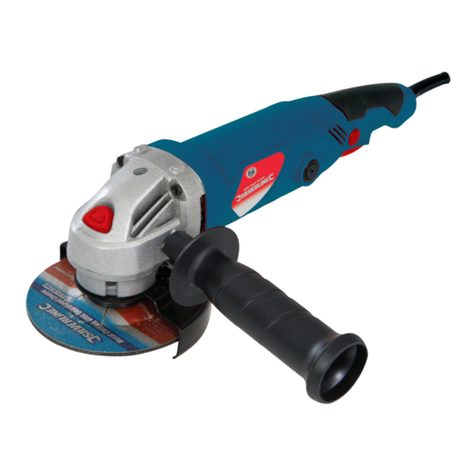
Silverline
Silverline 563709 Original instructions

Bavaria
Bavaria BAG 125/1 Original operating instructions
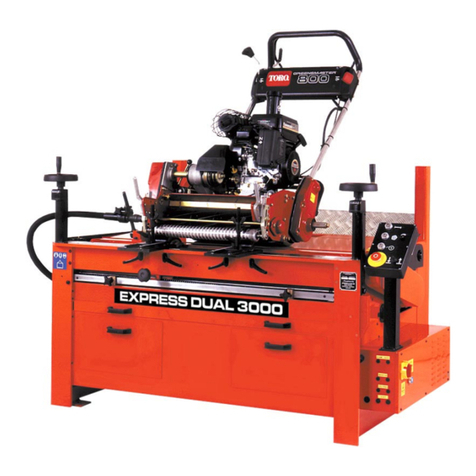
Bernhard
Bernhard Express Dual 3000 User guide/instruction manual
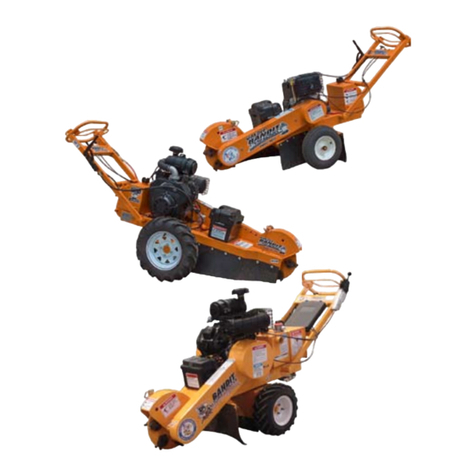
Brush Bandit
Brush Bandit HB19 Operating & parts manual
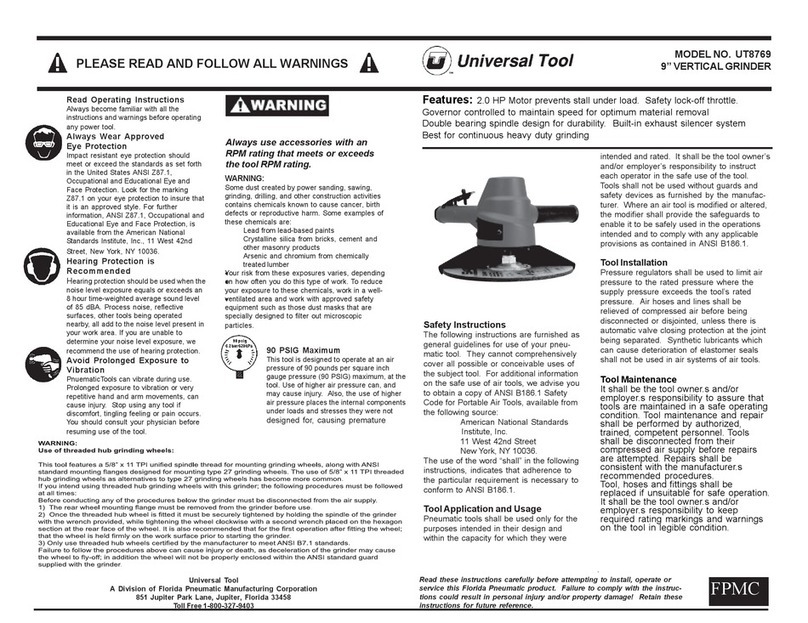
Universal Tool
Universal Tool UT8769 operating instructions
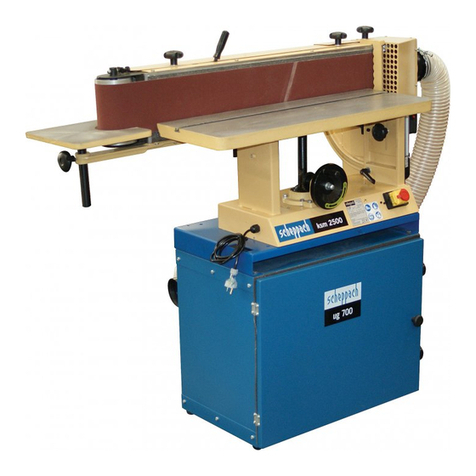
Scheppach
Scheppach ksm 2500 Translation from the original instruction manual


